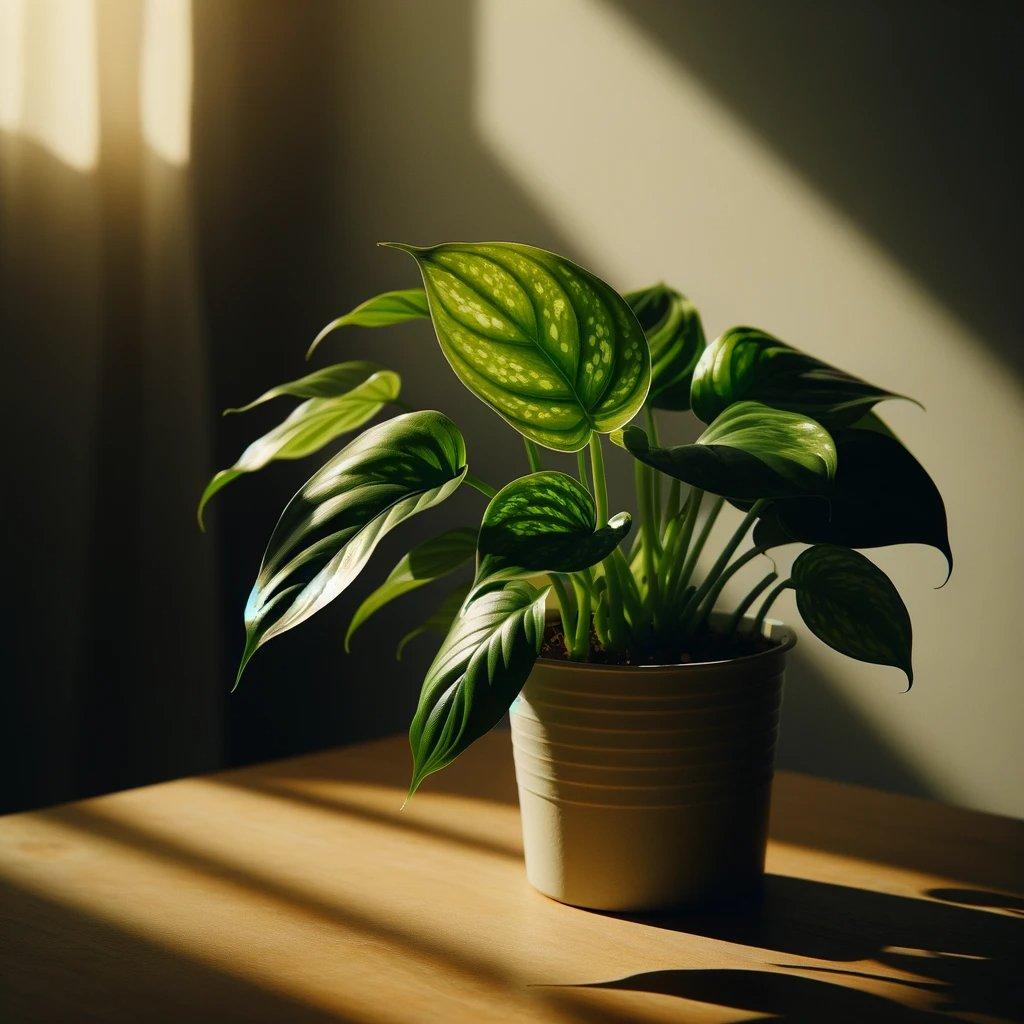An Overview: Golden Pothos at a Glance
Botanical Name: Epipremnum aureum
Nicknames: Golden Pothos, Devil’s Ivy, Money Plant, Devil’s Vine, Taro Vine, Soloman’s Ivy.
The Golden Pothos is a fast-growing and hardy plant that is tolerant of a wide variety of growing conditions. The trailing plant is easy to take care of and hard to kill, making it great for beginners. The waxy green, heart-shaped leaves are variegated with yellow and gold and love to vine themselves to their surroundings or hang down from hanging baskets.
While it prefers bright, indirect light, it can also tolerate low-light conditions and thrive on neglect. These plants are excellent at purifying the air of formaldehyde, benzene, and carbon monoxide while also helping eliminate odors. It can also help relieve eye irritation from staring at computer screens.

Plant Type and Growth
As a versatile and adaptable houseplant, Devil’s Ivy belongs to the category of perennial evergreens. This trailing vine is famous for its ability to grow long and luscious, with vines that can stretch over 10 feet in indoor settings. Its growth habit makes it perfect for hanging baskets, high shelves, or even as a lush green curtain in a room!
📏 Mature Size: More Than Just a Desk Plant
Don’t underestimate this humble houseplant; Golden Pothos can reach impressive sizes. Indoors, it typically grows up to 6-10 feet in length. However, in its natural habitat or given the right conditions, it can stretch even beyond that, showcasing its true vigorous nature.
☀️ Light Requirements: Thriving in Varied Sun Exposures
One of the reasons for its popularity is its tolerance for different light conditions. Money Plant prospers in everything from low light to bright, indirect sunlight. However, too little light may reduce the variegation in the leaves, while too much direct sun can scorch them.
🌱 Soil Savvy
Epipremnum aureum isn’t fussy about soil. It prefers well-draining, high-quality potting soil that can retain a bit of moisture without becoming soggy. This balance ensures the roots get enough hydration without the risk of rot.
pH Preference: A Slight Lean Towards Acidic
Devil’s Vine favors a slightly acidic to neutral soil pH, typically between 6.1 and 6.5. This range helps the plant absorb nutrients effectively, contributing to its lush, vibrant foliage.
🌸 A Bloom? Maybe Not Indoors
While Taro Vine does bloom in its natural tropical forest habitat, it rarely flowers indoors. The plant’s focus in home settings is on leaf growth, making it an ideal foliage plant.
Hardiness Zones and Native Roots
Originally hailing from the understory of tropical forests in Southeast Asia, Devil’s Ivy is hardy in USDA zones 10-12. In these regions, it’s not just a domestic plant but grows wildly, often seen adorning tree trunks and sprawling across forest floors.
Toxicity: A Caution for Pet Owners
A word of caution for pet lovers: Money Plant is toxic when ingested. Its leaves contain calcium oxalate crystals, which can cause irritation and swelling of the mouth, tongue, and throat in pets and humans.
The Golden Pothos, with its easy-going nature and visually appealing foliage, is more than just a plant. It’s a statement of resilience and beauty, adaptable to various indoor environments.
Pothos Plant Care
Watering: Balancing Moisture and Dryness
Watering is a crucial element in the care of Pothos. This plant prefers its soil to be on the drier side, so it’s essential to let the soil dry out between watering. Over-watering can lead to root rot, a common issue with indoor plants. Here’s how you can get it right:
- Check the Soil: Before watering, stick your finger about an inch into the soil. If it feels dry, it’s time to water.
- Water Thoroughly: When you do water, do it thoroughly so that water reaches the entire root system.
- Drainage is Key: Ensure that your pot has good drainage to avoid water accumulation at the bottom.
- Seasonal Adjustments: Reduce watering frequency in the winter months when the plant’s growth slows down.
Fertilizer: Boosting Growth and Health
Golden Pothos isn’t a heavy feeder, but it does benefit from occasional fertilization. Here’s how to provide the right nutrient boost:
- Type of Fertilizer: Use a balanced, water-soluble fertilizer, ideally one formulated for indoor plants.
- Frequency: Fertilize your Pothos once every 1-2 months during the growing season (spring and summer).
- Avoid Over-fertilization: Too much fertilizer can harm the plant. If you notice salt buildup or a white crust on the soil surface, it’s a sign to cut back.
Pruning: Shaping and Encouraging Fuller Growth
Pruning is a great way to shape your Pothos and encourage fuller growth. Regular pruning can also keep the plant healthy by removing any yellow or damaged leaves. Here’s how to do it:
- Best Time to Prune: Late spring or early summer is ideal.
- Technique: Use clean, sharp scissors or pruning shears. Cut just above a leaf node (the point where a leaf attaches to the stem).
- Control Growth: Regular pruning helps control the length of the vines and promotes more bushy growth.
Propagating: Creating New Plants
Propagation of Golden Pothos is simple and rewarding. It can be done using stem cuttings. Follow these steps:
- Cut a Stem: Choose a healthy stem with at least 4-5 leaves and cut it just below a node.
- Rooting Medium: You can root the cutting in water or directly in soil. If using water, change it every few days.
- Planting: Once the roots are a few inches long, plant the cutting in the soil.
Potting and Repotting Golden Pothos
Potting and repotting play a pivotal role in the health and growth of your Pothos (Epipremnum aureum). This resilient plant is not overly demanding about its potting conditions, but giving it the right home can significantly enhance its beauty and vitality. Let’s break down the best practices for potting and repotting this lustrous vine.
Choosing the Right Pot
The choice of pot for your Golden Pothos can impact its health. Here are some key points to consider:
- Material: Pots made from materials like terra cotta or ceramic are excellent choices as they allow the soil to breathe and help prevent water accumulation.
- Size: Start with a pot that’s slightly larger than the root ball. A pot that’s too large can lead to waterlogging issues.
- Drainage: Opt for a pot with adequate drainage holes. This is crucial in preventing water buildup and the associated risk of root rot.
When to Repot
Golden Pothos doesn’t mind being a bit root-bound, but it will eventually need more space to continue growing. Here are the signs that it’s time to repot:
- Roots Are Crowding: If you see roots starting to grow through the drainage holes or circling the surface of the soil, it’s time for a new pot.
- Slowed Growth: A noticeable slowdown in growth can indicate that your plant needs more room to expand.
- Watering Frequency: If you find yourself needing to water more often than usual, this can be a sign that the plant has outgrown its pot.
Repotting Steps
Repotting a Golden Pothos is straightforward. Follow these steps for a smooth transition:
- Prepare the New Pot: Fill it with a layer of fresh potting mix.
- Gently Remove the Plant: Tip the current pot sideways and gently coax the plant out. Be careful not to damage the roots.
- Inspect the Root Ball: Trim any excessively long or damaged roots.
- Place in New Pot: Set the plant in the new pot and fill it with more potting mix. Tap the pot gently to settle the soil.
- Water Thoroughly: After repotting, water the houseplant well to help settle the soil around the roots.
Aftercare
Post-repotting, place your Pothos in a location where it receives bright, indirect light. Avoid fertilizing immediately after repotting to allow the plant to settle in its new home. Within a few weeks, your Golden Pothos should start showing signs of new growth, a clear indication of a successful repot.
Pest and Disease Management
While generally resistant to pests and diseases, Golden Pothos can occasionally face issues like mealybugs, spider mites, and root rot. Here’s how to tackle them:
- Pest Control: If you notice pests, use a neem oil solution or insecticidal soap. Regularly wiping the leaves can prevent pest infestations.
- Avoiding Diseases: Prevent fungal diseases by avoiding over-watering and ensuring good air circulation around the plant.
- Inspect Regularly: Regularly check your plant for signs of distress, such as yellowing leaves or stunted growth.

Pros and Cons
| Pros | Cons |
|---|---|
| Easy to Care For: Ideal for beginners due to its low maintenance requirements. | Toxic to Pets and Humans: Contains calcium oxalate crystals, which can be harmful if ingested. |
| Adaptable to Light Conditions: Thrives in a range of light environments, from low light to bright, indirect light. | Prone to Root Rot: Overwatering can easily lead to root rot, requiring careful watering practices. |
| Air Purifying Qualities: Known for its ability to filter and improve indoor air quality. | Can Become Leggy: Without adequate light, the plant can become leggy and lose its lush appearance. |
| Rapid Growth: Features fast growth, making it gratifying to watch and ideal for filling spaces. | Regular Pruning Needed: Requires pruning to keep it from becoming too long and unruly. |
| Easy Propagation: Easily propagated through stem cuttings in water or soil, making it simple to multiply your collection. | Limited Flowering: Rarely flowers indoors, which might be a downside for those who prefer flowering plants. |
| Versatile in Placement: Can be hung, placed on shelves, or allowed to trail, offering various decorative possibilities. | May Attract Pests: Like many houseplants, it can attract pests such as mealybugs or spider mites if not properly cared for. |
Frequently Asked Questions About Devil’s Ivy
Q: Why is Golden Pothos also called Devil’s Ivy? A: It’s nicknamed Devil’s Ivy because of its hardiness and ability to survive in a wide range of environments. The plant is nearly impossible to kill, thriving even in poor light and neglect, much like the persistent nature associated with a ‘devil’.
Q: Can you explain the plant care required for Pothos? A: Caring for a Pothos plant is straightforward, making it a popular choice for plant parents. The plant thrives in medium to low indirect light and Pothos prefers its soil to dry out between waterings. Overwatering should be avoided to prevent yellowing leaves. The plant requires little care, making it ideal for both seasoned gardeners and beginners.
Q: How do I distinguish between a Pothos and a Philodendron? A: While similar in appearance, Pothos (Epipremnum aureum) and Philodendron can be distinguished by their leaves. Pothos typically have heart-shaped leaves with distinctive variegation and aerial roots that are thicker. Philodendron leaves tend to be thinner with a glossier texture.
Q: What are the ideal humidity conditions for Pothos houseplants? A: Soloman’s Ivy houseplants thrive in average household humidity but appreciate higher humidity levels. They are native to the islands in the South Pacific, where humidity levels are higher. However, they’re adaptable and can tolerate a range of humidity conditions.
Q: How do Pothos plants contribute to indoor air quality? A: Pothos is renowned for its ability to filter indoor pollutants such as formaldehyde from the air, making it not just a decorative plant but also a functional addition to your indoor space.
Q: What are some popular varieties of Pothos? A: Some popular varieties include the Marble Queen Pothos, known for its creamy white variegation, and the common Pothos, which typically features green leaves with yellow or white streaks. Each variety has its unique leaf patterns and colors.
Q: Is it easy to propagate Pothos houseplants? A: Yes, propagating is very easy. They can be propagated by cutting a stem with leaves and placing it in water. The stem will root in water, and once the roots are established, it can be planted in soil. This makes it easy for plant enthusiasts to share and multiply their plants.
Q: Are Pothos plants toxic? A: Yes, these plants are toxic to humans and pets if ingested. The leaves contain calcium oxalate crystals, which can cause irritation and discomfort. It’s important to keep the plant out of reach of pets and children.
Q: How often should I water my plant? A: Water your Pothos every 1-2 weeks, allowing the soil to dry out between waterings. The frequency may vary depending on the humidity and light conditions. In winter, when the plant is not actively growing, water less frequently.
Q: What kind of potting mix is best for my houseplant? A: A well-draining potting mix is ideal for Pothos. An indoor potting mix that includes components like peat, perlite, and vermiculite works well to ensure proper drainage and aeration for the roots.
Q: Why do the leaves of my Pothos turn yellow? A: Yellowing leaves on a Pothos plant can be a sign of overwatering or poor drainage. Ensure the plant isn’t sitting in water and the soil has time to dry out between waterings. Also, consider if the plant is receiving too much direct sunlight, which can also cause yellowing leaves.
Q: Can Golden Pothos be used as a container plant? A: Absolutely! Pothos makes an excellent container houseplant. Its cascading vines and vibrant foliage make it a beautiful addition to any room as a hanging plant or on shelves where the vines can drape down gracefully.
Q: How does Golden Pothos respond to different light conditions? A: The plant is adaptable to various light conditions. It grows best in medium to low indirect light but can also tolerate lower light levels. In too much direct sunlight, the leaves might turn yellow or get scorched.
Q: What is the growth rate of a Pothos? A: Pothos is a fast-growing plant, especially in optimal conditions with adequate light and water. It can add several inches of growth in a growing season, making it a satisfying plant for those who love to see quick progress in their plant care efforts.

